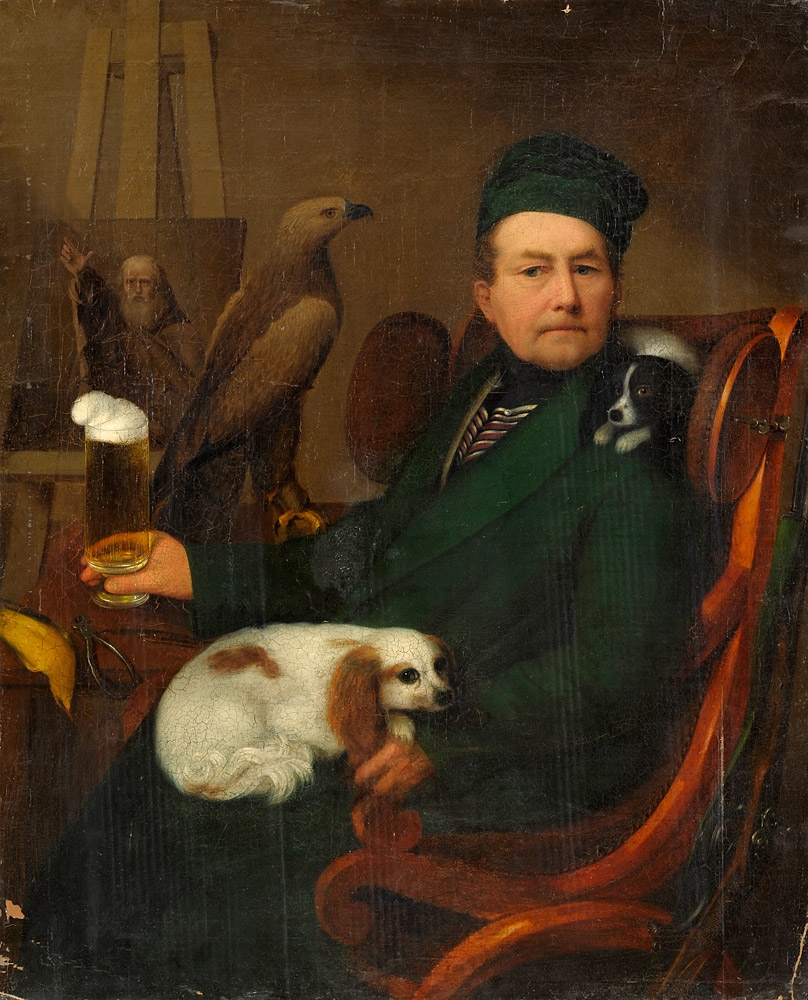When medieval brewers crossbred baker’s yeast with a wild species, we got thirst-quenching lager. Now TU scientists kick-started the wild strain to produce another fine beer.
Ever since yeast S. eubayanus was discovered brewers have tried to brew beer with the wild yeast in hopes of creating a new market. Giebelhausen Herrenportrait mit Hunden. (Image: Wikimedia Commons)
Delft researchers have ‘boosted’ a wild ancestor of the yeast that brewers have been using for centuries to make pilsner, allowing this strain to also produce beer, lager with a funky, wild taste.
“Beer brewers are always on the lookout for new flavours,” asserted Arthur Gorter de Vries (Faculty of Applied Sciences), one of the authors of a recent paper in PLOS Genetics that describes the feat that was performed in collaboration with Heineken.
Though the research incentive was finding new beer yeasts and new flavours, the biggest merit in the study lies in the experimental confirmation of a long hypothesized evolutionary mechanism. The research sheds light on the important question of how new genes appear.
Pilsner yeast arose by mating the domesticated baker’s yeast Saccharomyces cerevisiae with a recently rediscovered wild species, Saccharomyces eubayanus. It wasn’t until 2011 that an international team of researchers discovered S. eubayanus in a forest in Argentina.
Ales — an older form of beer — ferment at relatively high temperatures using baker’s yeast Saccharomyces cerevisiae. In the 15th century, brewers in central Europe began looking for ways to work at colder temperatures, and they inadvertently crossbred S. cerevisiae with S. eubayanus.
A brand-new protein
S. eubayanus strains cannot ferment maltotriose, the second-most common sugar in wort, the barley malt extract that is fermented into beer. The Delft researchers figured out how modern lager yeast could have adopted the sugar-hungry traits essential to their success. They were able to make the yeast evolve a brand-new protein capable of transporting maltotriose into the cell.
Gorter de Vries explains the importance of this finding: “For more than a century, researchers have thought that, from time to time, new gene functions evolved after cells accidentally made a copy of one of their existing genes. According to this theory, the ‘extra’ gene copy can then evolve freely. In this way, it can acquire a new function, while the original gene ensures that the original function is retained. We have observed this evolutionary mechanism in action for the first time.”
The researchers irradiated millions of S. eubayanus cells with UV light, causing DNA damage. This meant that the cells had to repair much more hereditary material than would normally be the case, which increased the chance of random mutations. The researchers then fed the microorganisms with a very limited amount of wort, forcing them to compete for what little food was available.
‘What an amazing example of the beauty and awesome power of evolution’
The yeast cells quickly ate all the simple sugars. All that was left was maltotriose, so it became increasingly advantageous for yeast cells to develop an ability to eat this large and complex sugar molecule. And that was exactly what happened.
“We suddenly noticed a drop in the amount of maltotriose,” said Delft researcher Nick Brouwers. So at least one yeast cell had found a way to consume maltotriose. “The descendants of that one cell had a large quantity of food available, so they quickly outcompeted all the other yeast cells.”
The researchers isolated some of the mutated cells and analysed their genome to find out what had changed. “Normally, we find that only a small number of changes have occurred,” explained Gorter de Vries. “In this case, however, a new gene had evolved. It contained large sections of DNA from three other genes. The real surprise was how quickly the hybrid gene came into being.”
In the same issue of PLOS Genetics, researchers from the University of Wisconsin–Madison also describe the emergence of a novel maltotriose transporter, by a mechanism similar to what Delft researchers observed. “Is it serendipity or evolutionary fate? Either way, what an amazing example of the beauty and awesome power of evolution,” said Gorter de Vries.
The newly evolved yeast cells have been tested and can, indeed, be used to brew lager. Beer that is brewed using this yeast combines the exotic flavours of wild yeast with the fresh taste of lager, according to the researchers. “Its taste lies somewhere in the middle between white beer and lager.”
- Nick Brouwers, Arthur R. Gorter de Vries, et.al., ‘In vivo recombination of Saccharomyces eubayanus maltose-transporter genes yields a chimeric transporter that enables maltotriose fermentation’, PLOS Genetics, April 4 2019
- DOI: 10.1371/journal.pgen.1007853
Do you have a question or comment about this article?
tomas.vandijk@tudelft.nl


Comments are closed.